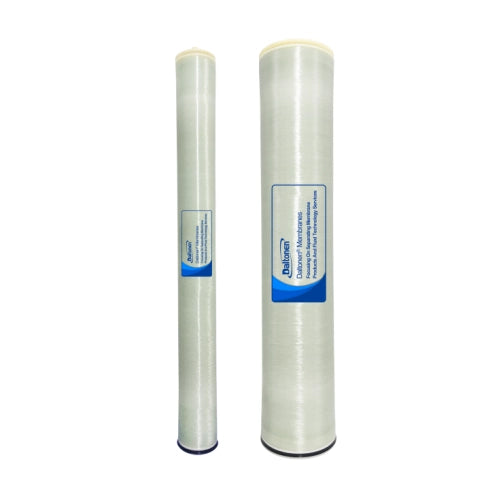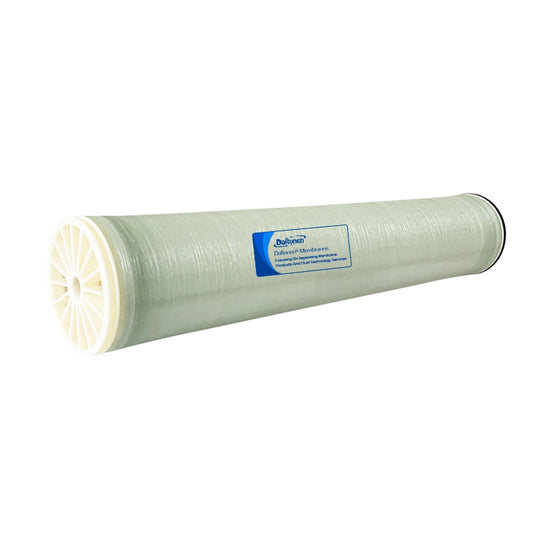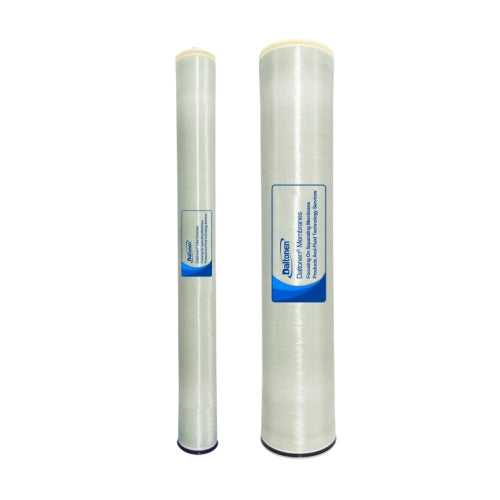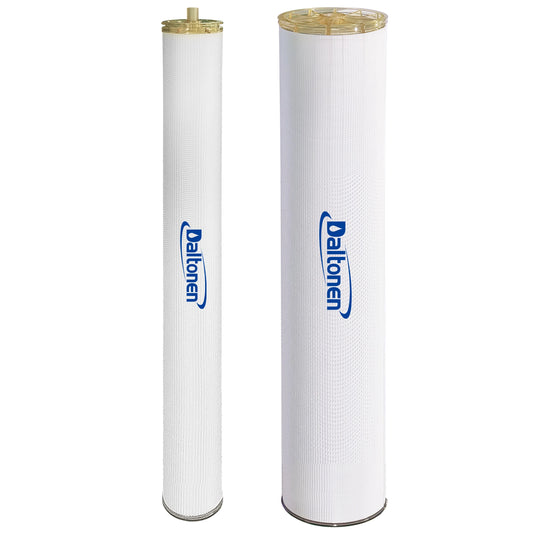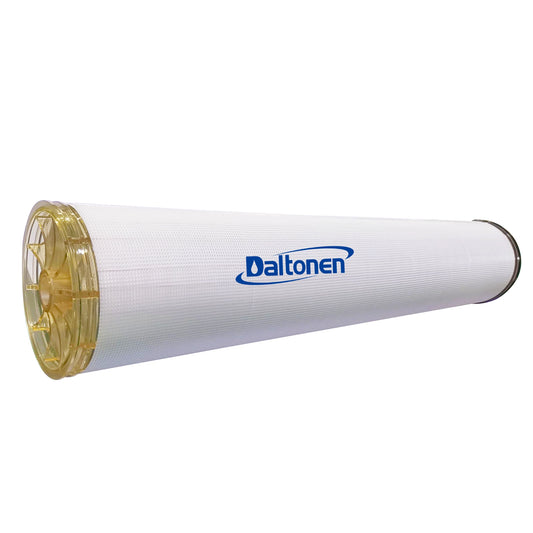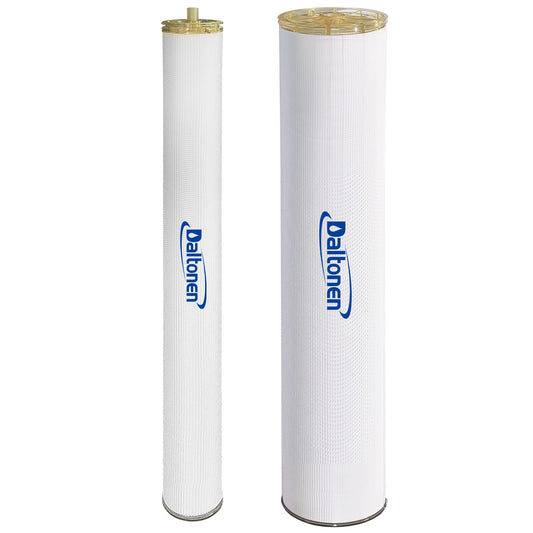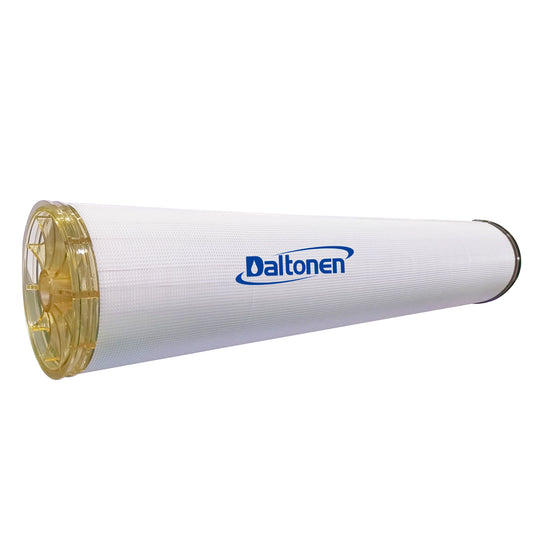NF Membrane Selection for Decolorization of Pesticide Wastewater
20 May 2025
1. Background of NF Membrane Selection for Decolorization of Pesticide Wastewater
1.1 Characteristics of Pesticide Wastewater
Pesticide wastewater is characterized by its complex composition, high organic concentration, deep color, high toxicity, and difficulty in degradation. One of the main features of pesticide wastewater is its high organic concentration, with chemical oxygen demand (COD) typically ranging from several thousand to tens of thousands of milligrams per liter. For instance, the wastewater from a pesticide manufacturing enterprise may have a COD value as high as 30,000 mg/L, posing a significant challenge for wastewater treatment. Moreover, pesticide wastewater contains a variety of hard-to-degrade organic substances, such as aromatic compounds and polychlorinated biphenyls, which have high chemical stability and biological toxicity and are difficult to remove through conventional biological treatment methods. In terms of color, the color of pesticide wastewater usually ranges from 500 to 1,000 times, mainly originating from dyes, pigments, and organic intermediates used in the production process. These high-color substances not only affect the sensory properties of water bodies but may also pose potential hazards to the ecological environment and human health. For example, high-color wastewater in natural water bodies can hinder the penetration of sunlight, affecting the photosynthesis of aquatic plants and thereby disrupting the ecological balance of water bodies.
1.2 Advantages of NF Membrane Technology
NF membrane technology has significant advantages in treating pesticide wastewater. Firstly, the pore size of NF membranes lies between that of reverse osmosis membranes and ultrafiltration membranes, typically ranging from 1 to 2 nanometers, which can effectively intercept organic substances with relative molecular weights between 200 and 1,000. For hard-to-degrade organic substances and pigments in pesticide wastewater, the interception rate of NF membranes can reach over 90%. For example, in an experiment on pesticide wastewater treatment, the interception rate of phenolic substances in the wastewater by NF membranes reached 95%, significantly reducing the organic concentration and color of the wastewater. Secondly, NF membranes generally do not require the addition of chemical agents during operation, avoiding the problem of secondary pollution. Compared with traditional chemical precipitation and activated carbon adsorption methods, NF membrane technology not only has more stable treatment effects but also lower operating costs. In a pesticide wastewater treatment project, the operating cost of using NF membrane technology to treat wastewater was only 60% of that of traditional chemical treatment methods. In addition, NF membrane technology has relatively low operating pressure, usually ranging from 0.5 to 1.5 megapascals, with low energy consumption and is suitable for large-scale industrial applications. When treating high-concentration pesticide wastewater, NF membranes can effectively reduce the color and organic concentration of wastewater while recovering some valuable substances, achieving the recycling of resources.

2. Key Factors in NF Membrane Selection
2.1 Membrane Material Selection
The material of NF membranes is an important factor affecting their performance and application effectiveness. Common NF membrane materials include polyamide, polyethersulfone, and polysulfone.
-
Polyamide Membranes: Polyamide membranes have high interception rates and selectivity, with significant removal effects on organic substances and pigments. Their surfaces carry negative charges, which can enhance the interception of charged organic substances through electrostatic interactions. For example, in the treatment of pesticide wastewater containing phenolic organic substances, the interception rate of polyamide NF membranes can reach over 95%. Moreover, polyamide membranes have good chemical resistance and can adapt to a variety of chemical environments with longer service life.
-
Polyethersulfone Membranes: Polyethersulfone membranes have good hydrophilicity and anti-fouling properties, which can effectively reduce the accumulation of dirt on the membrane surface and extend the service life of the membrane. They have uniform pore size distribution and high interception rates for organic substances with relative molecular weights between 200 and 1,000. In practical applications, polyethersulfone NF membranes can achieve an interception rate of over 85% for organic substances and pigments in pesticide wastewater. Additionally, polyethersulfone membranes have high mechanical strength and can withstand higher operating pressures, making them suitable for large-scale industrial applications.
-
Polysulfone Membranes: Polysulfone membranes have high mechanical strength and chemical stability and can adapt to a wide range of pH values. Their larger pore sizes provide better interception effects for large molecular organic substances. In the treatment of high-color pesticide wastewater, polysulfone NF membranes can effectively reduce the color of the wastewater with an interception rate of over 80%. Moreover, polysulfone membranes have good high-temperature resistance and can operate stably at higher temperatures, making them suitable for treating high-temperature wastewater.
2.2 Determination of Membrane Pore Size
The pore size of the membrane is one of the key parameters in NF membrane selection and directly affects its interception effect on organic substances and pigments in pesticide wastewater.
-
Pore Size Range: The pore size of NF membranes typically ranges from 1 to 2 nanometers, which can effectively intercept organic substances with relative molecular weights between 200 and 1,000. For hard-to-degrade organic substances and pigments in pesticide wastewater, NF membranes with a pore size of around 1.5 nanometers have better interception effects. For example, in an experiment on pesticide wastewater treatment, NF membranes with a pore size of 1.5 nanometers achieved an interception rate of 95% for phenolic substances in the wastewater and a color removal rate of over 90%.
-
Pore Size Distribution: The uniformity of pore size distribution also affects the performance of NF membranes. Uniform pore size distribution can improve the interception efficiency and selectivity of the membrane. By controlling the membrane preparation process, the pore size distribution can be optimized. For example, NF membranes prepared by phase inversion can have uniform pore size distribution by adjusting parameters such as polymer concentration and solvent evaporation rate. Experiments have shown that NF membranes with uniform pore size distribution have a 15% higher removal efficiency for organic substances in pesticide wastewater compared to membranes with non-uniform pore size distribution.
-
Pore Size Selection in Practical Applications: In practical applications, the appropriate membrane pore size should be selected based on the specific composition of the pesticide wastewater and the treatment requirements. For wastewater containing a large amount of small molecular organic substances, NF membranes with smaller pore sizes can be chosen to improve the interception rate. For wastewater containing large molecular organic substances, NF membranes with larger pore sizes can be selected to ensure flux and treatment efficiency. For example, in the treatment of pesticide wastewater containing a large amount of aromatic organic substances, NF membranes with a pore size of 1.2 nanometers can effectively intercept these organic substances while maintaining a high flux. The treated wastewater has an 80% reduction in COD and a 90% reduction in color.
3. Design of NF Membrane Decolorization Process for Pesticide Wastewater
3.1 Pretreatment Steps
Pretreatment is a key link in the NF membrane treatment process for pesticide wastewater. Its purpose is to reduce the pollution load of the wastewater, prevent membrane fouling, and improve the operating efficiency and service life of the NF membrane.
-
Removal of Suspended Solids and Large Particles: Pesticide wastewater often contains suspended solids and large particles, which can block the pores of NF membranes and increase the risk of membrane fouling. Physical methods such as screens and sedimentation tanks are commonly used to remove these impurities. For example, in a pesticide wastewater treatment project, screens were used to remove suspended solids with a particle size greater than 5 millimeters from the wastewater, and then sedimentation tanks were used to remove suspended solids with a particle size less than 5 millimeters, reducing the suspended solids content in the wastewater to below 50 milligrams per liter and effectively reducing the possibility of membrane fouling.
-
Adjustment of Wastewater pH: The performance of NF membranes is significantly affected by the pH value of the wastewater. Most NF membranes perform best in the pH range of 6 to 8. By adding acids or bases to the wastewater to adjust the pH value, the operating conditions of the NF membrane can be optimized. For example, for pesticide wastewater with a pH of 3, the pH was adjusted to 7 by adding sodium hydroxide solution, which increased the interception rate of the NF membrane by 10% and the flux by 20%.
-
Removal of Partial Organic Substances: Pretreatment can also remove part of the organic substances, reducing the organic concentration of the wastewater and alleviating the treatment load on the NF membrane. Common methods include coagulation sedimentation and activated carbon adsorption. For example, in the pretreatment of pesticide wastewater, coagulation sedimentation was used to remove 30% of the chemical oxygen demand (COD) from the wastewater, and then activated carbon adsorption was used to remove an additional 20% of the COD, reducing the COD value of the wastewater entering the NF membrane system to 10,000 milligrams per liter, creating favorable conditions for the efficient operation of the NF membrane.
3.2 Membrane Separation Operating Conditions
The optimization of NF membrane separation operating conditions is crucial for improving the decolorization effect of pesticide wastewater and reducing operating costs.
-
Operating Pressure: Operating pressure is an important factor affecting the flux and interception rate of NF membranes. Generally, the higher the operating pressure, the greater the membrane flux. However, excessive pressure can lead to accelerated membrane fouling and increased energy consumption. When treating pesticide wastewater, an operating pressure between 0.5 and 1.5 megapascals is usually chosen. For example, in an experiment on pesticide wastewater treatment, when the operating pressure was increased from 0.5 megapascals to 1.0 megapascals, the flux of the NF membrane increased from 15 liters per square meter per hour to 25 liters per square meter per hour. However, when the pressure was further increased to 1.5 megapascals, the flux only increased to 28 liters per square meter per hour, while the rate of membrane fouling significantly accelerated. Therefore, it is necessary to reasonably select the operating pressure based on the specific conditions of the wastewater and the performance of the NF membrane.
-
Temperature Control: Temperature also has a significant impact on the performance of NF membranes. Higher temperatures can reduce the viscosity of the wastewater and increase the membrane flux. However, excessive temperatures can lead to a decline in the performance of the membrane material. In practical applications, the operating temperature of NF membranes is generally controlled between 20 and 40 degrees Celsius. For example, when treating pesticide wastewater, increasing the operating temperature from 20 degrees Celsius to 30 degrees Celsius increased the flux of the NF membrane by 10% and the color removal rate by 5%. However, when the temperature exceeded 40 degrees Celsius, the interception rate of the membrane decreased by 10%, indicating that excessive temperature had an adverse effect on the membrane performance.
-
Flow Rate Adjustment: The adjustment of flow rate can affect the flow state of the wastewater on the membrane surface, reduce concentration polarization, and improve the interception efficiency of the membrane. In the process of treating pesticide wastewater with NF membranes, cross-flow filtration is usually adopted, with the flow rate generally controlled between 1 and 3 meters per second. For example, in a pesticide wastewater treatment project, when the flow rate was increased from 1 meter per second to 2 meters per second, the interception rate of the NF membrane increased from 85% to 90%, and the flux increased by 15%. However, when the flow rate was further increased to 3 meters per second, the flux only increased by 5%, while the energy consumption significantly increased. Therefore, it is necessary to reasonably select the flow rate based on the nature of the wastewater and the characteristics of the NF membrane to achieve the best treatment effect and balance of operating costs.

4. Performance Evaluation and Optimization of NF Membranes
4.1 Decolorization Efficiency Evaluation
The decolorization efficiency of NF membranes in treating pesticide wastewater is one of the key indicators for measuring their performance. The level of decolorization efficiency directly affects whether the treated wastewater meets environmental discharge standards.
-
Color Removal Rate: Experimental data is used to compare the decolorization effects of different NF membranes on pesticide wastewater. For example, in an experiment using polyamide NF membranes to treat pesticide wastewater, the color of the wastewater was reduced from 800 times to 80 times, achieving a color removal rate of 90%. This indicates that polyamide NF membranes have high decolorization efficiency when treating high-color pesticide wastewater.
-
Correlation between COD Removal Rate and Decolorization Efficiency: In the treatment of pesticide wastewater, there is a certain correlation between COD removal rate and decolorization efficiency. Generally, as the COD removal rate increases, the color also correspondingly decreases. For example, in a pesticide wastewater treatment project, the COD removal rate of the NF membrane reached 85%, and the color removal rate also reached 80%. This shows that while the NF membrane removes organic substances, it also effectively reduces the color of the wastewater.
-
Long-term Decolorization Stability: During long-term operation, the decolorization efficiency of NF membranes may be affected by factors such as membrane fouling. By monitoring the decolorization efficiency of NF membranes after continuous operation for a period of time, their stability and reliability can be assessed. For example, in a long-term experiment on the treatment of pesticide wastewater with NF membranes, after continuous operation for 30 days, the color removal rate of the NF membrane remained above 85%, indicating that the NF membrane has good long-term decolorization stability.
4.2 Membrane Fouling and Cleaning Strategies
Membrane fouling is one of the main problems faced by NF membranes during use. It can reduce the flux and interception efficiency of the membrane and increase operating costs.
-
Types and Causes of Membrane Fouling: Membrane fouling of NF membranes mainly includes organic fouling, inorganic fouling, and biological fouling. Organic fouling mainly originates from the adsorption and deposition of organic substances in pesticide wastewater on the membrane surface; inorganic fouling is caused by the crystallization and precipitation of inorganic salts in the wastewater on the membrane surface; biological fouling is formed by the proliferation of microorganisms in the wastewater on the membrane surface. For example, when treating pesticide wastewater containing a large amount of aromatic organic substances, NF membranes are prone to organic fouling, leading to a decrease in membrane flux.
-
Selection of Cleaning Methods: Choosing the appropriate cleaning method is crucial for different types of membrane fouling. Physical cleaning methods include backwashing and air stirring, which can remove loose pollutants on the membrane surface; chemical cleaning methods include acid cleaning, alkali cleaning, and oxidant cleaning, which can remove stubborn pollutants on the membrane surface. For example, for NF membranes severely affected by organic fouling, a combination of alkali cleaning and oxidant cleaning can achieve a flux recovery rate of over 80%.
-
Determination of Cleaning Cycle: A reasonable cleaning cycle can effectively extend the service life of NF membranes and reduce operating costs. The cleaning cycle should be determined based on a comprehensive consideration of the membrane fouling situation and operating conditions. For example, in a pesticide wastewater treatment project, by monitoring the flux changes of the NF membrane, it was found that when the membrane flux dropped to 60% of the initial flux, a cleaning was performed, which could restore the membrane flux to over 85% of the initial flux and ensure stable membrane performance after cleaning. Therefore, this cleaning cycle was determined to be a suitable one.
-
Evaluation of Cleaning Effectiveness: The effectiveness of cleaning is mainly measured by the flux recovery rate and interception rate recovery rate of the membrane. For example, in an experiment on the cleaning of NF membranes, the flux recovery rate reached 90% and the interception rate recovery rate reached 95% after cleaning, indicating good cleaning effectiveness and effective restoration of the performance of the NF membrane.
5. Conclusion
NF membrane technology has shown significant advantages and broad application prospects in the decolorization treatment of pesticide wastewater. By thoroughly analyzing the key factors in NF membrane selection, process design, and performance evaluation and optimization, efficient, economical, and sustainable solutions can be provided for pesticide wastewater treatment.
5.1 Key Points of NF Membrane Selection
The selection of NF membranes needs to take into account multiple factors such as membrane material, pore size, and operating conditions. Different materials of NF membranes, such as polyamide, polyethersulfone, and polysulfone, each have their own advantages and are suitable for pesticide wastewater with different compositions and treatment requirements. The precise selection of pore size can effectively balance the interception rate and flux to ensure treatment effectiveness and operating efficiency. In addition, the optimization and adjustment of operating pressure, temperature, and flow rate are crucial for improving the decolorization efficiency of NF membranes and reducing operating costs.
5.2 Importance of Process Design
Reasonable process design is the foundation for the efficient operation of NF membranes. Pretreatment steps can effectively reduce the pollution load of wastewater, reduce the risk of membrane fouling, and extend the service life of NF membranes. By removing suspended solids, adjusting the pH value, and removing part of the organic substances, optimal operating conditions can be created for the NF membrane. At the same time, optimizing the operating conditions of membrane separation can further enhance the decolorization performance and treatment efficiency of NF membranes, achieving efficient decolorization treatment of pesticide wastewater.
5.3 Sustainability of Performance Evaluation and Optimization
The performance evaluation and optimization of NF membranes is an ongoing process. The evaluation of decolorization efficiency should not only focus on short-term treatment effects but also pay attention to long-term operational stability. By monitoring key indicators such as color removal rate, COD removal rate, and membrane flux, membrane fouling issues can be identified in a timely manner and corresponding cleaning strategies can be adopted. The selection of appropriate cleaning methods and cycles can effectively restore the performance of NF membranes, reduce operating costs, and ensure the long-term efficient operation of NF membranes in the decolorization treatment of pesticide wastewater.
Tags:
